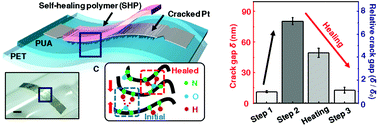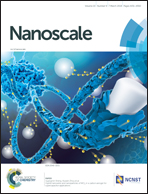A semi-permanent and durable nanoscale-crack-based sensor by on-demand healing†
Abstract
Although sensitivity and durability are desirable in a sensor, both of them cannot be easily achieved. Site-specific and effective signal acquisition on the limited area of a sensor inevitably allows fatigue accumulation and contamination. For example, an ultrasensitive nanoscale-crack-based sensor for detecting a mechanical stimulus with tremendous sensitivity (a gauge factor greater than 2000 under 2% strain), yet limited durability (up to a few thousand stretching cycles in tensile tests) has been presented previously. Herein, we suggest a simple yet robust nanoscale-crack-based sensor that achieves remarkable durability through the use of a self-healable polymer. The self-healable polymer helps the crack gap recover and maintain high stability for 1 million cycles under 2% strain. Moreover, site-specific recovery with infrared light irradiation was demonstrated with monolithic arrayed sensors. The proposed strategy provides a unique solution to achieving highly enhanced durability and high mechanosensitivity, which are typically incompatible.



 Please wait while we load your content...
Please wait while we load your content...